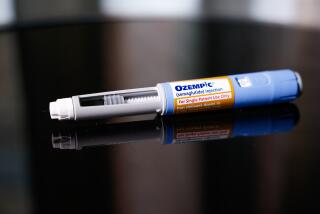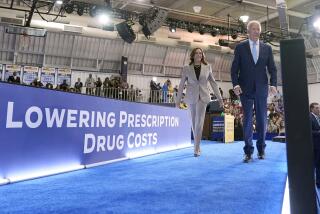When will the healthcare law lower drug costs?
- Share via
Reporting from Washington — Many seniors today find themselves unable to afford prescription drugs even if they have a drug benefit plan under Medicare. The healthcare bill that became law last month aims to fix this problem. But many of those provisions won’t be fully implemented for years.
What is the “doughnut hole,” and how do I know if I’m in it?
Seniors who are enrolled in a Medicare Part D plan pay 25% of the cost of prescription drugs until the total reaches $2,830. At that point, enrollees must pay the full cost of their drugs until their total out-of-pocket spending reaches $4,550, when catastrophic coverage kicks in and the enrollee pays 5% of drug costs for the rest of the year.
The gap between the yearly limit and the point at which catastrophic coverage kicks in is called the “doughnut hole.” If you’ve seen a sudden and steep increase in the cost of your prescriptions since January, you’ve probably reached the doughnut hole.
According to a recent study led by Susan Ettner, a professor at UCLA’s Geffen School of Medicine, there were 3.4 million people enrolled in the Medicare Part D program in 2006. About 16% entered the coverage gap. Nearly 3% reached it within the first three months of the year. Those most likely to reach the doughnut hole were women and people with diabetes and dementia, the study found.
I thought the healthcare bill was supposed to make my drugs cheaper. Why haven’t my costs gone down?
Starting in 2011, drug costs will be lower for those in the doughnut hole as discounts on brand-name and generic drugs are phased in over the next nine years. Though no discounts will apply this year, the law provides a one-time $250 rebate -- available starting June 15 -- for those who have reached the doughnut hole.
If the discounts are being phased in, how many years will it take for my drug costs to really go down?
For brand-name drugs, a 50% discount will take effect in 2011. By 2015, you will be responsible for 45% of the cost; by 2018, your share will be reduced to 35%.
For generic drugs, your costs will be reduced 7% each year, beginning in 2011. In 2015, you will pay 65% of the cost of generic drugs; by 2018, you will pay 44%.
By 2020, enrollees will pay 25% of the cost of brand-name and generic drugs until their yearly out-of-pocket spending has reached the level for catastrophic coverage to kick in.
More to Read
Inside the business of entertainment
The Wide Shot brings you news, analysis and insights on everything from streaming wars to production — and what it all means for the future.
You may occasionally receive promotional content from the Los Angeles Times.










